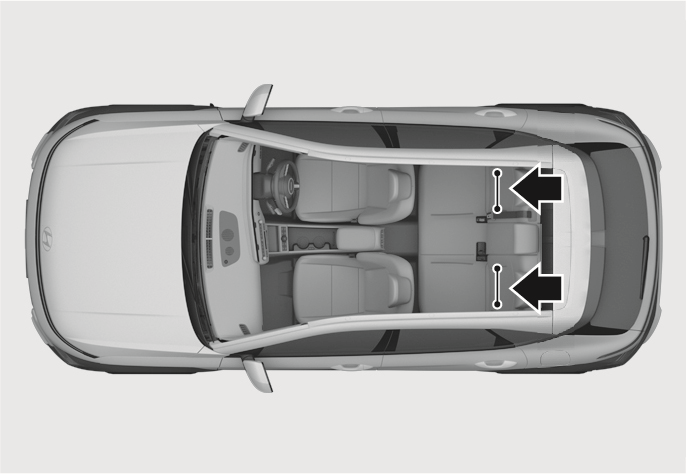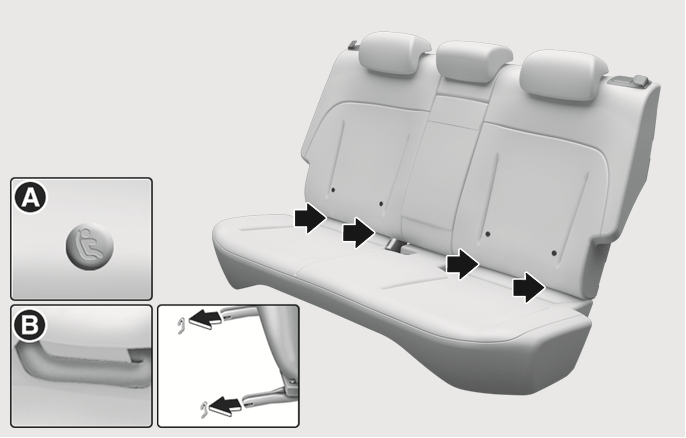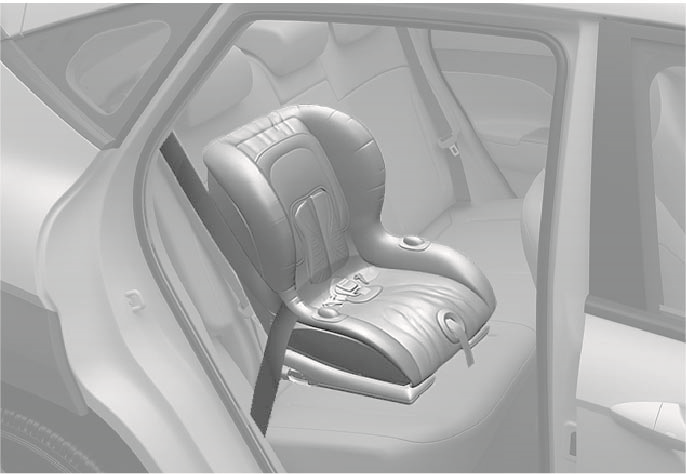Installing a Child Restraint System (CRS)
Before installing your Child Restraint System always:
Read and follow the instructions provided by the manufacturer of the Child Restraint System.
Failure to follow all warnings and instructions could increase the risk of the SERIOUS INJURY or DEATH if a collision occurs.
If the vehicle headrest prevents proper installation of a Child Restraint System, the headrest of the respective seating position should be readjusted or entirely removed.
After selecting a proper Child Restraint System for your child and checking that the Child Restraint System fits properly on the seating position, there are three general steps for a proper installation:
-
Properly secure the Child Restraint System to the vehicle. All Child Restraint Systems must be secured to the vehicle with the lap belt or lap part of a lap/shoulder belt or with the ISOFIX top tether and/or ISOFIX anchorage and/or with the support leg.
-
Make sure the Child Restraint System is firmly secured. After installing a Child Restraint System to the vehicle, push and pull the seat forward and from side-to-side to verify that it is securely attached to the seat. A Child Restraint System secured with a seat belt should be installed as firmly as possible. However, some side-to-side movement can be expected.
When installing a Child Restraint System, adjust the vehicle seat and seatback (up and down, forward and rearward) so that your child fits in the Child Restraint System in a comfortable manner.
-
Secure the child in the Child Restraint System. Make sure the child is properly strapped in the Child Restraint System according to the Child Restraint System manufacturer’s instructions.
A Child Restraint System in a closed vehicle can become very hot. To prevent burns, check the seating surface and buckles before placing your child in the Child Restraint System.
The ISOFIX system holds a Child Restraint System during driving and in a collision. This system is designed to make installation of the Child Restraint System easier and reduce the possibility of improperly installing your Child Restraint System. The ISOFIX system uses anchors in the vehicle and attachments on the Child Restraint System. The ISOFIX system eliminates the need to use seat belts to secure the Child Restraint System to the rear seats.
ISOFIX anchorages are metal bars built into the vehicle. There are two lower anchors for each ISOFIX seating position that will accommodate a Child Restraint System with lower attachments.
To use the ISOFIX system in your vehicle, you must have a Child Restraint System with ISOFIX attachments. (An ISOFIX-seat may only be installed if it has vehicle-specific or universal approval in accordance with the requirements of relevant regulation.)
The Child Restraint System manufacturer will provide you with instructions on how to use the Child Restraint System with its attachments for the ISOFIX anchorages. (CRS with universal approval to relevant regulations need to be fixed additionally with a top tether strap connected to the corresponding top tether anchorage point on the back side of the rear seats.)

2C_ALRSeatBeltLowerAnchorOverview
ISOFIX anchorages have been provided in the left and right outboard rear seating positions. Their locations are shown in the illustration. There are no ISOFIX anchorages provided for the centre rear seating position.
Do not attempt to install a Child Restraint System using ISOFIX anchorages in the rear centre seating position. There are no ISOFIX anchorages provided for this seat. Do not use the outboard seat anchorages for the CRS installation on the rear centre seating position. It may damage the anchorages that may break or fail in a collision resulting in serious injury or death.

2C_ALRSeatBeltLowerAnchor
- ISOFIX anchorage position indicator (Type A-
 , Type B-
, Type B-  )
) - ISOFIX anchorage
The ISOFIX anchorage position indicator symbols are located on the left and right rear seatbacks to identify the positions of the ISOFIX anchorages in your vehicle.
The ISOFIX anchorages are located between the seatback and the seat cushion of the rear seat left and right outboard seating positions.
Before installing the Child Restraint System, make sure that there are no objects (e.g. toys, pens, wires) near the ISOFIX anchorage area. Those objects may damage either the seat belt system or the Child Restraint System during installation. If necessary, we recommend that your vehicle be inspected by an authorised HYUNDAI dealer.
To install an i-Size or ISOFIX-compatible Child Restraint System in either of the rear outboard seating positions:
-
Move the seat belt buckle away from the ISOFIX anchorages.
-
Move any other objects away from the anchorages that could prevent a secure connection between the Child Restraint System and the ISOFIX anchorages.
-
Place the Child Restraint System on the vehicle seat, then attach the seat to the ISOFIX anchorages according to the instructions provided by the Child Restraint System manufacturer.
-
Follow the instructions of the Child Restraint System’s manufacturer for proper installation and connection of the ISOFIX attachments on the Child Restraint System to the ISOFIX anchorages.
Take the following precautions when using the ISOFIX system:
-
Read and follow all installation instructions provided with your Child Restraint System.
-
To prevent the child from reaching and taking hold of unretracted seat belts, buckle all unused rear seat belts and retract the seat belt webbing behind the child. Children can be strangled if a shoulder belt becomes wrapped around their neck and the seat belt tightens.
-
NEVER attach more than one Child Restraint System to a single anchorage. This could cause the anchor or attachment to come loose or break.
-
Always have the ISOFIX system inspected by your dealer after a collision. A collision can damage the ISOFIX system and may not properly secure the Child Restraint System.
First secure the child restraint with the ISOFIX anchorages or the seat belt. If the child restraint manufacturer recommends that the top tether strap be attached, attach and tighten the top tether strap to the top tether strap anchorage.

2C_ALRSeatBeltTetherAnchor
Top tether anchorages for Child Restraint Systems are located on the rear of the seatbacks.

2C_ALRSeatBeltTetherAnchorInstall
To install the top tether anchorage:
-
Route the Child Restraint System top tether strap over the seatback. When placing the top tether strap, please follow the instructions of the Child Restraint System manufacturer.
-
Connect the top tether strap to the top tether anchorage, then tighten the top tether strap according to the instructions of your Child Restraint System’s manufacturer to firmly attach the Child Restraint System to the seat.
-
Check the Child Restraint System is secure by pushing and pulling the seat forward and back and side-to-side.
Take the following precautions when installing the top tether anchorage:
-
Read and follow all installation instructions provided with your Child Restraint System.
-
NEVER attach more than one Child Restraint System to a single ISOFIX top tether anchorage. This could cause the anchorage or attachment to come loose or break.
-
Do not attach the top tether strap to anything other than the correct top tether anchorage for that seating position. It may not work properly if attached to something else.
-
Child Restraint System anchorages are designed to withstand only those loads imposed by correctly fitted child restraints.
Under no circumstances are they to be used for adult seat belts or harnesses, or for attaching other items or equipment to the vehicle.
When not using the ISOFIX system, all Child Restraint Systems must be secured to a rear seat with the lap part of a lap/shoulder belt.
Always place a rear-facing child restraint in the rear seat of the vehicle.
Placing a rear-facing child restraint in the front seat can result in serious injury or death if the child restraint is struck by an inflating airbag.
Extreme hazard! Do not use a rearward facing child restraint on a seat protected by an airbag in front of it!
Installing a Child Restraint System with a lap/shoulder belt
To install a Child Restraint System on the rear seats:
-
Place the Child Restraint System on a rear seat and route the lap/shoulder belt around or through the Child Restraint System, following the Child Restraint System manufacturer’s instructions. Make sure the seat belt webbing is not twisted.

2C_ALRSeatBeltInstall
-
Fasten the lap/shoulder belt latch into the buckle. Listen for the distinct “click” sound.

2C_ALRSeatBeltInstall_2
Position the release button so that it is easy to access in case of an emergency.
-
Remove as much slack from the belt as possible by pushing down on the Child Restraint System whilst feeding the shoulder belt back into the retractor.

2C_ALRSeatBeltInstall_5
-
Push and pull on the Child Restraint System to confirm that the seat belt is holding it firmly in place.
If your Child Restraint System manufacturer recommends the use of a top tether with the lap/shoulder belt, refer to the “Securing a Child Restraint System seat with “Top Tether Anchorage” system” section in this chapter.
To remove the Child Restraint System, press the release button on the buckle and then pull the lap/shoulder belt out of the Child Restraint System and allow the seat belt to retract fully.
If the child seat moves, readjust the length of the seat belt. In Australia/ New Zealand the child restraint manufacturer’s instructions must be followed when fitting the unit to the vehicle.